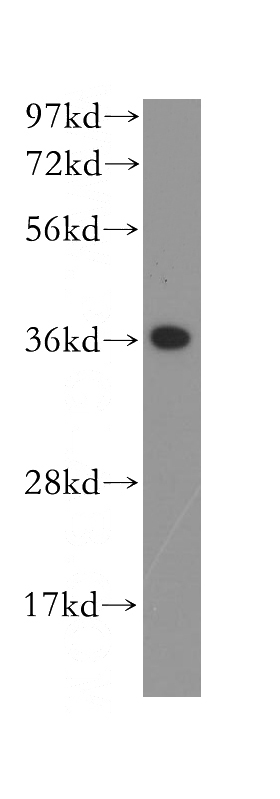-
Product Name
ANKRD1 antibody
- Documents
-
Description
ANKRD1 Rabbit Polyclonal antibody. Positive WB detected in human heart tissue, rat skeletal muscle tissue. Observed molecular weight by Western-blot: 36kd
-
Tested applications
ELISA, WB
-
Species reactivity
Human,Mouse,Rat; other species not tested.
-
Alternative names
ALRP antibody; ANKRD1 antibody; bA320F15.2 antibody; C 193 antibody; C193 antibody; Cardiac ankyrin repeat protein antibody; CARP antibody; CVARP antibody; HA1A2 antibody; MCARP antibody
-
Isotype
Rabbit IgG
-
Preparation
This antibody was obtained by immunization of ANKRD1 recombinant protein (Accession Number: NM_014391). Purification method: Antigen affinity purified.
-
Clonality
Polyclonal
-
Formulation
PBS with 0.1% sodium azide and 50% glycerol pH 7.3.
-
Storage instructions
Store at -20℃. DO NOT ALIQUOT
-
Applications
Recommended Dilution:
WB: 1:500-1:5000
-
Validations

human heart tissue were subjected to SDS PAGE followed by western blot with Catalog No:108064(ANKRD1 antibody) at dilution of 1:400
-
Background
Ankyrin repeat domain-containing protein 1(ANKRD1) belongs to the conserved muscle ankyrin repeat protein(MARP) family, whose expression is induced in response to physiologic stress, injury and hypertrophy. Thus its expression mainly in activated vascular endothelial cells. ANKRD1 may regulate SMC proliferation throught the CDKN1A pathway. It functions as a nuclear transciption regressor that regulate cardiac gene's expression. This is a rabbit polyclonal antibody produced by the full-length ANKRD1 of human origin
-
References
- Sorrentino G, Ruggeri N, Specchia V. Metabolic control of YAP and TAZ by the mevalonate pathway. Nature cell biology. 16(4):357-66. 2014.
- Chadwick JA, Hauck JS, Lowe J. Mineralocorticoid receptors are present in skeletal muscle and represent a potential therapeutic target. FASEB journal : official publication of the Federation of American Societies for Experimental Biology. 29(11):4544-54. 2015.
Related Products / Services
Please note: All products are "FOR RESEARCH USE ONLY AND ARE NOT INTENDED FOR DIAGNOSTIC OR THERAPEUTIC USE"
